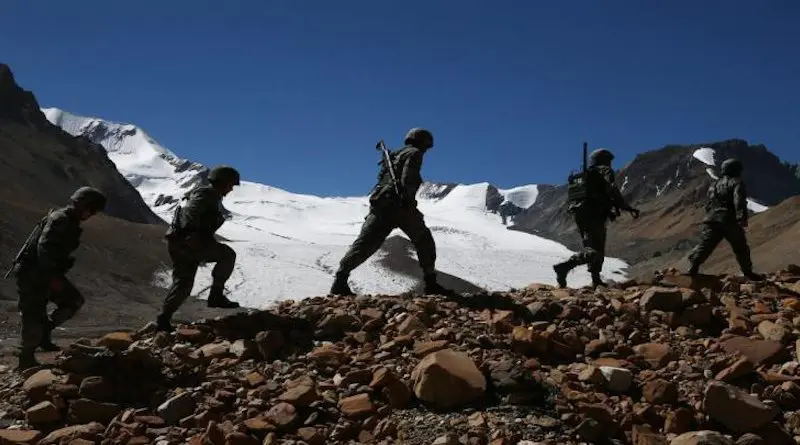Chinese Land-Grab In Bhutan And India: Timid Responses Won’t Work With Beijing – Analysis
By Lt Gen Prakash Katoch (retd)*
The world is wiser with the emergence of documentary evidence that China discussed weaponizing the SARS virus since 2015, together with studying the effects of a biological strike including on the health-hospital infrastructure of the target country and put in place the propaganda to absolve itself of any blame before bombing the world with the “Wuhan Virus” in 2019. The installation of Tedros Adhanom Ghebreyesus as the Director-General of World Health Organization in July 2017 was part of the plan which paid off – terming the “Wuhan Virus” as Covid-19.
The obfuscation from China’s ‘biological war crimes’ continues with the focus shifting to mutants from different countries, leaving Beijing in the clear. However, China is gradually coming into the limelight for all the wrong reasons. For the first time, the United Nations has discussed China’s atrocities against Uyghurs in the Xinjiang Uyghur Autonomous Region. Concurrently, some international media has recently covered the construction of a Chinese village inside Bhutan terrritory, which is not an isolated incident.
China has been using ‘legal warfare’ to manufacture historical claims on foreign territories. This entails giving Chinese names to places along with fabricating records to strengthen illegal claims. Beijing has given Chinese names to many places in the Indian state of Arunachal Pradesh which it illegally claims as South Tibet. In November 2020, media reported China had built a village called ‘Pangda’ along the Torsa river just inside the southwestern border of Bhutan.
Shen Shiwei, a senior producer with Chinese CGTN News, posted images of the village established in what he said was the Doklam area and later indicated the precise location of the settlement. However, Beijing and Thimphu both issued denials.
Chinese village in Bhutan
Now satellite imagery has emerged of a Chinese village ‘Gyalaphug’, said to have been constructed two km inside Bhutan, with a new road leading to it. There have also been reports that other areas of Western Bhutan have been gradually encroached by China to secure access to the border with India.
According to Foreign Policy magazine, “In October 2015, China announced that a new village, called Gyalaphug in Tibetan or Jieluobu in Chinese, had been established in the south of the Tibet Autonomous Region. But Gyalaphug is in Bhutan. This new construction is part of a major drive by Chinese President Xi Jinping since 2017 to fortify the Tibetan borderlands, a dramatic escalation in China’s long-running efforts to outmaneuver India and its neighbors along their Himalayan frontiers”.
Chinese intentions of setting up such border villages are quite obvious. Not only do these villages help substantiate China’s illegal territorial claims, these dwellings house Peoples Liberation Army personnel and intelligence operatives mixed with locals. The Chinese tactics include developing cross-border civilian links using money and provisioning of rations to recruit agents and guides for covert missions and operations. China also encourages cross-border marriages with the same aim, as it has done in Myanmar and Pakistan.
That Bhutan has denied the above villages are in its territory is not surprising; it can hardly be expected to take on China. China occupied most of the Doklam Plateau within a month of the 73-day long India-China standoff having been called off in 2017, which was not reported in Bhutanese as well as Indian media.
Chinese village in Arunachal
In January 2021, a newly constructed Chinese village in Arunachal Pradesh was reported by media; located on banks of the River Tsari Chu in Upper Subansiri District some 4.5 km inside Indian territory. This news led to anti-China protests in Arunachal Pradesh with protesters burning effigy of Chinese President Xi Jinping. The All Arunachal Pradesh Students’ Union (AAPSU) condemned China’s expansionist designs and criticized New Delhi’s non-committal approach demanding firm counter-measures to check Beijing’s moves.
According to one media outlet that sent satellite images of the Chinese village to the Indian Ministry of External Affairs (MEA) raising questions about whether the Chinese village is in Indian territory, the MEA response was noncommittal. It said: “We have seen recent reports on China undertaking construction work along the border areas with India. China has undertaken such infrastructure construction activity in the past several years. Our Government too has stepped up border infrastructure including the construction of roads, bridges, etc, which has provided much-needed connectivity to the local population along the border.”
According to official records, the site of the above village had an Assam Rifles post till 1959 when it was run over by the Chinese but the area did not have any construction as per satellite images of August 26, 1999. However, subsequent satellite imagery of November 1, 2020, showed a full-fledged village with over 110 dwellings that have been constructed in about one year and the construction was on during the India-China standoff in Eastern Ladakh as well.
Obviously, China will continue to indulge in such land-grab activities, especially when it observes pusillanimous responses. India is still to squarely name China for its blatant aggression in Eastern Ladakh last year even as Beijing has backtracked on its promise of disengagement. Such perceived diplomatic niceties are considered cowardice by the Chinese Communist Party (CPC).
About the author: The author is an Indian Army veteran. Views are personal. He can be contacted at [email protected]
Source: This article was published by South Asia Monitor

